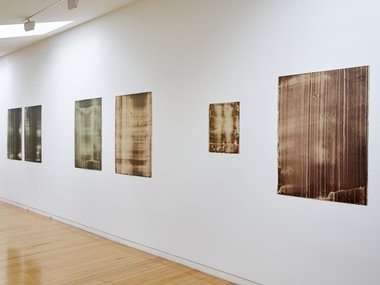John Hurrell – 18 July, 2019
The colour is mainly sepia, but sometimes it turns into an umberish green or dark sienna. The resulting marks are quite peculiar: a combination of the Shroud of Turin and the vertical wave patterns you might see with an ultrasound body scan or geological investigatory instrument—praeternatural mysticism meeting contemporary science.
Leigh Martin is mainly known for his toxic looking—’fruit-flavour coloured’—canvases made of yacht-hull lacquer, paintings which are holistic and mistily immersive. His more recent, darker and denser works at Two Rooms though are very different.
In the current show we see brown coloured, viscous, acrylic paint dragged (with a squeegee?) across the surface of heavy Fabriano cotton rag watercolour paper. There are three rectangular sizes, one large at 1500 x 1070 mm, most being 1050 x 770 mm, but a few being surprisingly intimate at 510 x 390 mm.
The colour is mainly sepia, but sometimes it turns into an umberish green or dark sienna. The resulting marks are quite peculiar: a combination of the Shroud of Turin and the vertical wave patterns you might see with an ultrasound body scan or geological investigatory instrument—praeternatural mysticism meeting contemporary science.
In fact they look like an odd sort of beguiling cameraless photograph. They don’t look like paintings (though they employ paint); they don’t look like drawings either (though the marks are on paper). The matte colour could also be that of old bloodstains. Slightly forensic in character: once crimson; now chocolate.
These intersecting aspects create ambiguous images presented on paper unframed and placed flush with the wall—using pins. They are rich in evocative associations: scraped striations with creepy stroboscopic Lynchian forms lurking in the background. Some are very blurry while others have crisper (more defined) edges. Overall their stainlike quality provides a softness, a smoky atmospheric sense of very slow movement. Your eye seeks out the dark spots or the glowing luminous areas (usually vertical streaks), and studies the relationships between the two.
While the clusters of vertical striations have sonic connotations, they also strangely suggest a horizontal resistance, a delaying countermotion, caught in the texture of the paper, that slows down the eye’s flow along the ‘landscape’. I say ‘landscape’ guardedly because some murky images look like eerie standing figures, architectural columns or vases on plinths, and seem a form of Surrealism, rather than abstraction linked to a manual process.
This is a wonderfully absorbing show, rich in evocative marks and mysterious processes that appear to be soaked in history. Leigh Martin at his very best.
John Hurrell














 Two Rooms presents a program of residencies and projects
Two Rooms presents a program of residencies and projects Advertising in this column
Advertising in this column



This Discussion has 0 comments.
Comment
Participate
Register to Participate.
Sign in
Sign in to an existing account.